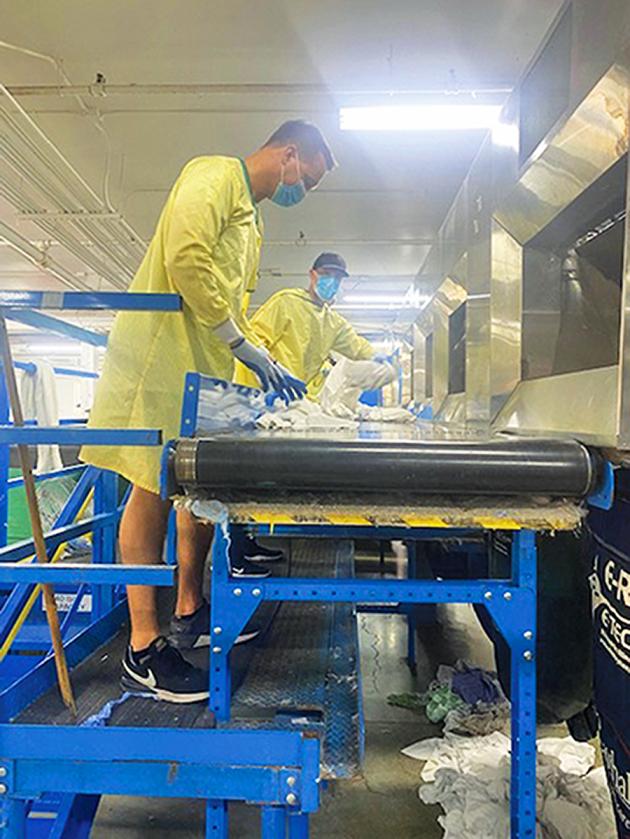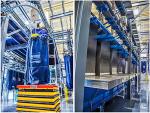TUMWATER, Wash. — In software engineering, the cost of detecting and fixing defects increases exponentially the farther they are discovered downstream.
A bug found during the design phase is simple and inexpensive to fix. Conversely, a bug found by an end user in a finished system costs orders of magnitude more.
The final consequences of downstream defects may even be injury or death as in the case of commercial aircraft or other mass transportation systems.
We follow this same principle with the healthcare laundering process at Sterile Surgical Systems. A high-quality soil sort for us is the first step in producing high-quality, hygienically clean healthcare linens for infection prevention and patient safety.
Errors in the sort lead to successively more severe and more expensive problems downstream.
In a worst-case scenario, a bad sort may even lead to serious injury or death for hospital patients or laundry/healthcare workers. Less severe, but still impactful, items missed in the sort may cause damage to expensive laundry equipment, causing costly downtime and quality problems.
SOIL SORT PURPOSE
Imagine a complex software system that was built with no design process. It would not work.
Now imagine a healthcare laundry with no soil sort process. Imagine a laundry where received soiled goods are emptied together into a washer, unloaded and then dried, and then sent to the finish for folding and shipping to the hospital.
Think of the abysmal quality of the final product. Visualize this contaminated linen touching sick patients. Picture the associated safety issues … needles, controlled substances, garbage, food and more all mixed together with the washed but unclean linen!
A quality soil sort operation prevents this condition. The purpose of the soil sort operation in our healthcare laundry is to separate received goods into categories so they can next be handled safely and appropriately.
In our accredited healthcare laundry, we generally have from 15 to 30 different soil sort categories. These can be broken down into bulk linens, specialty items, non-linen items and stain/out-of-service items.
Examples of bulk linen items include bath blankets, patient gowns, sheets, terry items pillowcases and incontinent pads.
Examples of specialty items include surgical textiles, cubicle curtains, lifter slings, microfiber cleaning devices, lab coats, scrubs and isolation gowns.
Non-linen item examples include garbage, sharps, pharmaceutical waste, surgical instruments, patient personal items, pens and staff personal items. Some non-linen items are harmless, but others must be handled carefully according to local and federal laws. For example, pharmaceutical waste received must follow a strict protocol.
Finally, stain/out-of-service items include textile items that should be taken out of service due to permanent stains, tears or simply overuse.
FROM OLD SCHOOL TO ARTIFICIAL INTELLIGENCE
In our plant, the soil sort process and technology have evolved considerably.
Originally, we had a team of six sorters stand around a spring cart. One person opened bags while five others sorted into 10 carts on the perimeter. This was slow, messy, dangerous and error prone.
Later, we built a sort platform with an incline conveyer moving goods up to another 60-foot straight conveyer. A bagger opened bags onto the incline conveyer while six sorters stood behind the straight conveyer and dropped given items into carts below.
This was faster, safer and more accurate but still a largely manual process. Cart weights were estimates and employees were responsible for manually moving full carts to the wash area and replacing them with empty carts.
Still later we installed a sort rail system from a reputable material handling vendor. We use this system currently.
This system also consists of a sort platform with an incline conveyer moving goods up to another 60-foot straight conveyor.
A bagger still opens bags onto the incline conveyer while six sorters stand behind the straight conveyer pulling given items. However, with this system the items are dropped into a hopper hooked to a sling bag.
The items are weighed and when the desired weight is reached, the sling bag is automatically removed, stored and replaced with a new bag. Sort productivity is measured, and sling bag contents are identified and tracked throughout the process.
This process is much more efficient, flexible, accurate and safe.
Moving forward, we want to take advantage of several emerging technologies that enhance safety accuracy and productivity. These include the following:
X-Ray Technology—Systems now exist that scan soiled textile bags for foreign objects including sharps, pharmaceuticals, pens and other non-linen items. When found, these bags are kicked out so they avoid employees, washers, extraction presses, dryers, etc.
Imagine, no more pens destroying a load of scrubs or sharps rupturing a press membrane.
RFID Technology—Like most healthcare laundries, we struggle with scrub losses and inventory tracking. There are now systems that can scan a load of scrubs (or other items) and then count how many came from each facility.
This will enable us to accurately report to customers how many scrubs they were sent and how many they returned to us.
Automatic Picking, Identifying and Sorting—This is “The Holy Grail.” I have seen demonstration artificial intelligence systems that perform the very human tasks of picking up a piece of linen, identifying it, and then sorting it into the proper bin.
I have yet to speak with laundries using these in production but when these systems mature, they will revolutionize the industry and we will be first in line to implement them.
SUMMARY
As with any complex software engineering project, the first step in establishing a high-quality healthcare laundry process is to focus resources to get the upstream correct. Invest the time and resources to develop an accurate high functioning sort operation.
The few extra seconds it takes employees to sort items accurately will pay exponential dividends in the safety, quality and productivity of your healthcare laundry operation.
More importantly, these relatively small investments will pay immeasurable gains downstream ultimately in infection prevention and patient safety!
Have a question or comment? E-mail our editor Matt Poe at [email protected].



















































































































































































































































